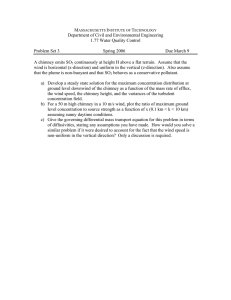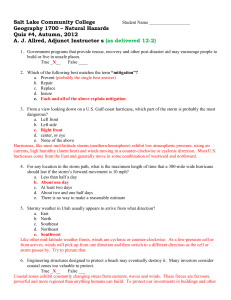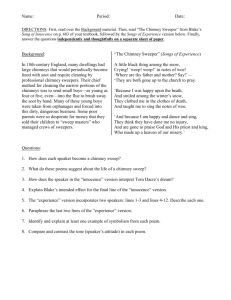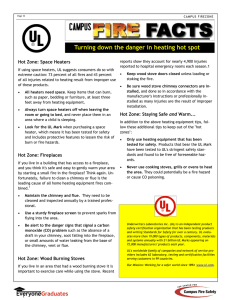IRJET-Carbon Particles Removing in Exhaust Gases
advertisement
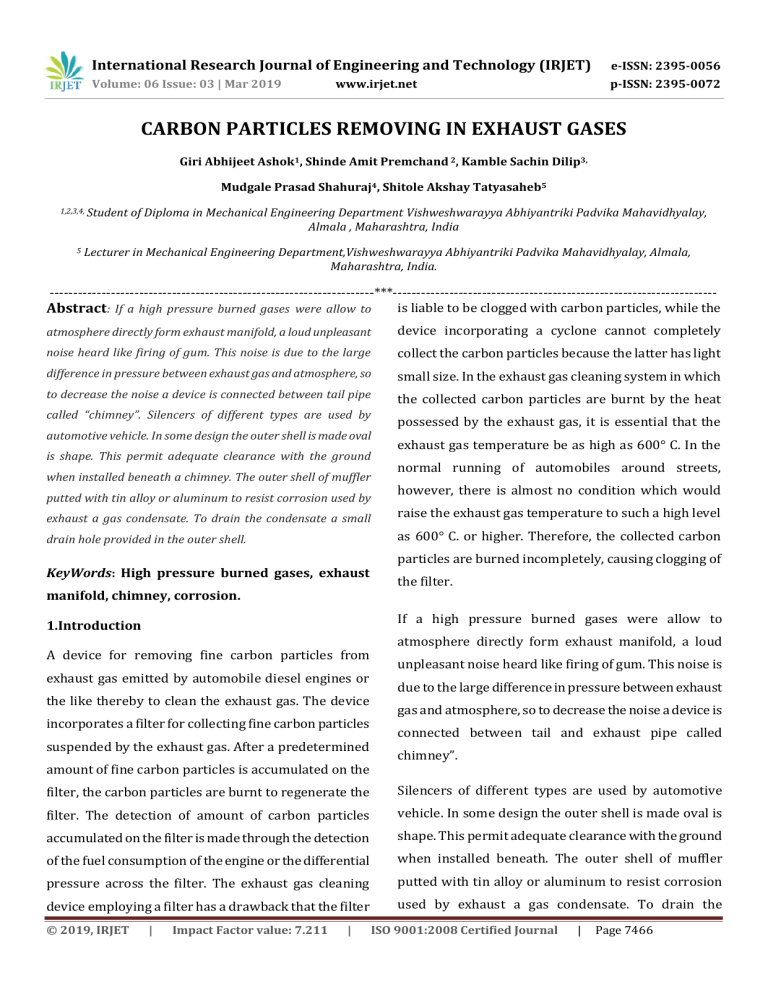
International Research Journal of Engineering and Technology (IRJET) e-ISSN: 2395-0056 Volume: 06 Issue: 03 | Mar 2019 p-ISSN: 2395-0072 www.irjet.net CARBON PARTICLES REMOVING IN EXHAUST GASES Giri Abhijeet Ashok1, Shinde Amit Premchand 2, Kamble Sachin Dilip3, Mudgale Prasad Shahuraj4, Shitole Akshay Tatyasaheb5 1,2,3,4, Student 5 of Diploma in Mechanical Engineering Department Vishweshwarayya Abhiyantriki Padvika Mahavidhyalay, Almala , Maharashtra, India Lecturer in Mechanical Engineering Department,Vishweshwarayya Abhiyantriki Padvika Mahavidhyalay, Almala, Maharashtra, India. ---------------------------------------------------------------------***--------------------------------------------------------------------is liable to be clogged with carbon particles, while the Abstract: If a high pressure burned gases were allow to atmosphere directly form exhaust manifold, a loud unpleasant device incorporating a cyclone cannot completely noise heard like firing of gum. This noise is due to the large collect the carbon particles because the latter has light difference in pressure between exhaust gas and atmosphere, so small size. In the exhaust gas cleaning system in which to decrease the noise a device is connected between tail pipe the collected carbon particles are burnt by the heat called “chimney”. Silencers of different types are used by automotive vehicle. In some design the outer shell is made oval is shape. This permit adequate clearance with the ground when installed beneath a chimney. The outer shell of muffler putted with tin alloy or aluminum to resist corrosion used by possessed by the exhaust gas, it is essential that the exhaust gas temperature be as high as 600° C. In the normal running of automobiles around streets, however, there is almost no condition which would exhaust a gas condensate. To drain the condensate a small raise the exhaust gas temperature to such a high level drain hole provided in the outer shell. as 600° C. or higher. Therefore, the collected carbon KeyWords: High pressure burned gases, exhaust manifold, chimney, corrosion. particles are burned incompletely, causing clogging of the filter. If a high pressure burned gases were allow to 1.Introduction A device for removing fine carbon particles from exhaust gas emitted by automobile diesel engines or the like thereby to clean the exhaust gas. The device incorporates a filter for collecting fine carbon particles suspended by the exhaust gas. After a predetermined amount of fine carbon particles is accumulated on the atmosphere directly form exhaust manifold, a loud unpleasant noise heard like firing of gum. This noise is due to the large difference in pressure between exhaust gas and atmosphere, so to decrease the noise a device is connected between tail and exhaust pipe called chimney”. filter, the carbon particles are burnt to regenerate the Silencers of different types are used by automotive filter. The detection of amount of carbon particles vehicle. In some design the outer shell is made oval is accumulated on the filter is made through the detection shape. This permit adequate clearance with the ground of the fuel consumption of the engine or the differential when installed beneath. The outer shell of muffler pressure across the filter. The exhaust gas cleaning putted with tin alloy or aluminum to resist corrosion device employing a filter has a drawback that the filter used by exhaust a gas condensate. To drain the © 2019, IRJET | Impact Factor value: 7.211 | ISO 9001:2008 Certified Journal | Page 7466 International Research Journal of Engineering and Technology (IRJET) e-ISSN: 2395-0056 Volume: 06 Issue: 03 | Mar 2019 p-ISSN: 2395-0072 www.irjet.net condensate a small drain hole provided in the outer Mercury has long been known as a potential health and shell. environmental hazard. Environmental standards for its emissions from coal fired power plants, petroleum and 2. Literature Review chemical refineries, incinerators, metal extraction Mercury emission from a flue gas such as that operations, and other mercury emitting facilities are generated by a coal fired power plant is controlled by becoming increasingly demanding. New regulations are injecting into the flue gas unburned carbon purified currently under development to reduce the permissible from ash such as fly ash or wood ash. The unburned levels of mercury emissions from such facilities. carbon adsorbs the mercury and is later removed from Technologies are under development to meet this the flue gas by a particle separator. The unburned challenge. One such technology utilizes activated carbon collected from ash is significantly lower in cost carbon to control mercury emissions from coal fired compared to activated carbon presently used in such a power plants. However, cost estimates show that process. The unburned carbon is concentrated in the commercialization of this technology would result in a sorbent by one or more separation processes used to five percent increase in electricity prices and that 95 remove non-carbon particles from the fly ash. percent of this increase is due to the cost of activated These processes include gravity separation, electrostatic separation, froth flotation, magnetic separation and size classification. Mercury adsorption is further increased by oxidation of the carbon surface. carbon. A minimum solid-to-gas ratio is usually required to ensure the adsorbate molecules, mercury in this case, in the gas phase have a reasonable chance to collide A method of removing mercury vapor from a stream of with adsorbent particles.Compared with activated flue gas utilizing unburned carbon collected from ash carbon, unburned carbon is generally low cost with a comprising the steps of: reasonable adsorptive capacity. Unburned carbon has preparing a carbon sorbent from ash by separating a more macro-pores, which allows the fast adsorption portion of the non-carbon particles from the ash and easy regeneration after loaded. Moreover, the trace resulting in a sorbent having a greater concentration of and minor elements or compounds present in the unburned carbon than the original ash; unburned carbons may enhance the adsorption of subsequently introducing the carbon sorbent into a mercury. flue gas stream whereby mercury in the flue gas stream is adsorbed by the unburned carbon in the sorbent; and subsequently collecting the mercury-laden carbon sorbent from the flue gas stream. The primary use of unburned carbon to remove mercury is in the flue gas from coal-fired power plants. However, it can be used to remove mercury from incineration flue gas, natural gas and the ventilation air from chloralkali processes. Further objects, features and advantages of the invention will become apparent © 2019, IRJET | Impact Factor value: 7.211 | ISO 9001:2008 Certified Journal | Page 7467 International Research Journal of Engineering and Technology (IRJET) e-ISSN: 2395-0056 Volume: 06 Issue: 03 | Mar 2019 p-ISSN: 2395-0072 www.irjet.net from a consideration of the following description and the 1950s, building codes in many locations require the appended claims when taken in connection with newly built chimneys to have a flue liner. Chimneys the accompanying drawings built without a liner can usually have a liner added, but the type of liner needs to match the type of appliance it 3. Construction services. Flue liners may be clay or concrete tile, metal, 3.1 Construction or poured in place concrete. 3.3 Chimney Pots, Caps And Tops A chimney pot is placed on top of the chimney to expand the length of the chimney inexpensively, and to improve the chimney's draft. A chimney with more than one pot on it indicates that multiple fireplaces on different floors share the chimney. Fig 3.1: Carved brick chimneys characteristic of late Gothic Tudorbuildings, at Thornbury Castle, 1514 A cowl is placed on top of the chimney to prevent birds As a result of the limited ability to handle transverse and other animals from nesting in the chimney. They loads with brick, chimneys in houses were often built often feature a rain guard to prevent rain or snow from in a "stack", with a fireplace on each floor of the house going down the chimney. A metal wire mesh is often sharing a single chimney, often with such a stack at the used as a spark arrestor to minimize burning debris front and back of the house. Today's central from rising out of the chimney and making it onto the heating systems have made chimney placement less roof. Although the masonry inside the chimney can critical, and the use of non-structural gas vent pipe absorb a large amount of moisture which later allows a flue gas conduit to be installed around evaporates, rainwater can collect at the base of the obstructions and through walls. chimney. Sometimes weep holes are placed at the In fact, most modern high-efficiency heating appliances do not require a chimney. Such appliances are bottom of the chimney to drain out collected water. 3.4 H-Style Cowl generally installed near an external wall, and a noncombustible wall thimble allows a vent pipe to run directly through the external wall. 3.2 Residential flue liners A flue liner is a secondary barrier in a chimney that protects the masonry from the acidic products of combustion, helps prevent flue gas from entering the house, and reduces the size of an oversized flue. Since © 2019, IRJET | Impact Factor value: 7.211 | Fig 4.3: H-Style Cowl ISO 9001:2008 Certified Journal | Page 7468 International Research Journal of Engineering and Technology (IRJET) e-ISSN: 2395-0056 Volume: 06 Issue: 03 | Mar 2019 p-ISSN: 2395-0072 www.irjet.net An H-style cap (cowl) is a chimney top constructed That causes the bottom of the vertical column of hot from chimney pipes shaped like the letter H. (Its image flue gas to have a lower pressure than the pressure at is included in cowl (chimney).) It is an age-old method the bottom of a corresponding column of outside air. of regulating draft in situations where prevailing winds That higher pressure outside the chimney is the driving or turbulences cause downdraft and backpuffing. force that moves the required combustion air into the Although the H cap has a distinct advantage over most combustion zone and also moves the flue gas up and other downdraft caps, it fell out of favor because of its out of the chimney. That movement or flow of bulky design. It is found mostly in marine use but has combustion air and flue gas is called "natural been regaining popularity due to its energy-saving draught/draft", "natural ventilation", "chimney effect", functionality. or "stack effect". The taller the stack, the more draught The H-cap stabilizes the draft rather than increasing it. Other downdraft caps are based on the Venturi or draft is created. 4. Working Principle effect, solving downdraft problems by increasing the updraft constantly resulting in much higher fuel consumption. 4.1 Working Principle It is, therefore, an object of the invention to provide a device for cleaning the exhaust gas by removing fine 3.5 Chimney Draught or Draft The stack effect in chimneys: the gauges represent absolute air pressure and the airflow is indicated with light grey arrows. The gauge dials move clockwise with carbon particles effectively even during running of the automobile around the streets, thereby to obviate the above-described problems of the prior art. increasing pressure. To this end, according to the invention, there is 3.5.1 Flue Gas Stack provided a device for removing fine carbon particles When coal, oil, natural gas, wood, or any other fuel is combusted in a stove, oven, fireplace, hot water boiler, or industrial furnace, the hot combustion product gases that are formed are called flue gases. from exhaust gas emitted by automobile engines or the like, characterized by comprising: first and second paths through which the exhaust gas from the engine is passed, a filter disposed in the first path and adapted to collect the fine carbon particles suspended in the Those gases are generally exhausted to the ambient exhaust gas, heating means disposed in the first path outside air through chimneys or industrial flue gas and adapted to burn the fine carbon particles collected stacks (sometimes referred to as smokestacks).The by the filter. combustion flue gases inside the chimneys or stacks are much hotter than the ambient outside air and A valve disposed at the juncture of both paths and therefore less dense than the ambient air. adapted to selectively open and close the paths and detecting means for detecting the amount of carbon particles collected by and accumulated on the filter, © 2019, IRJET | Impact Factor value: 7.211 | ISO 9001:2008 Certified Journal | Page 7469 International Research Journal of Engineering and Technology (IRJET) e-ISSN: 2395-0056 Volume: 06 Issue: 03 | Mar 2019 p-ISSN: 2395-0072 www.irjet.net 6 wherein the second path is opened by the valve and the heating means is activated when the amount of carbon Replacement of parts is easy 5.2 Disadvantages: particles collected by and accumulated on the filter has exceeded a predetermined amount. Initial cost is high. 5.3 Applications: The above and other objects, as well as advantageous features of the invention will become clear from the 1 Sugar Factory following description of the preferred embodiment of 2 Various Types Of Industry the invention taken in conjunction with the 6. Conclusion accompanying drawings. Percentages of carbon monoxide (CO) carbon dioxide 4.2 Working (CO2) and unburned hydrocarbon are reduced from As the gas liberated from exhaust valve passes through exhaust without change in the efficiency of the vehicle exhaust manifold. First it reaches into charcoal casing and noise also dumped due to the use of oil while the form the perforated tube where the co is absorbed by cost is low as comported to other types of silencer. charcoal powder charcoal and granule through a convergent section to tube which is immersed in oil. Also oil charcoal greatly reduced the harmful effecting human being accurse by vehicle pollution. Then gas reaches into the water chamber where the bubbles are formed and high mass bubbles are formed high mass bubbles are converted into low mass bubble 7. References 1) M.L. Mathur“Internal Combustion Engine ” In 2005 as the gas passes through liquid forming bubble. Process as burnt oil is used to absorb the amount of 2) Khopkar S. M. “Environment Pollution Analysis” In carbon monoxide (CO) and hydrocarbon (HC) as well 2011 as sound is dumped. Then gas is passed through glass wool chamber the glass wool remove carbon particles. 3) Kripal Singh “Automobile Engineering” In 2012 4) https://en.wikipedia.org/wiki/Chimney 5. Advantages, Disadvantages & Applications 5.1 Advantages: 1 It requires simple maintenance cares 2 Checking and cleaning are easy, because of the main parts are screwed. 3 Handling is easy. 4 Manual power not required 5 Repairing is easy. © 2019, IRJET | Impact Factor value: 7.211 | ISO 9001:2008 Certified Journal | Page 7470
